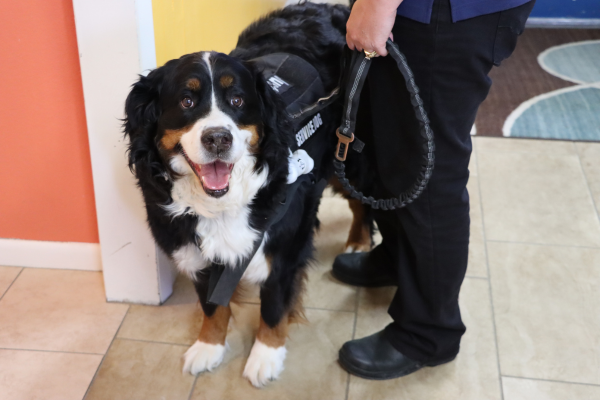Service dogs and their handlers work as a team to navigate life, and that includes being in public together. When someone sees a dog in public, they may be inclined to pet them or interact with them, but service dogs are focused on doing a job. Petting service dogs could impact their ability to follow commands and may even put their handler in danger. This includes offering them food or treats because they are often on a strict feeding schedule or specific diet. If you want to ask questions, approach and speak to the handler, not the dog. It is important to treat service dogs and their handlers with respect and give them their space.
Watch Sarah Dayton and her service dog Ollie go over some of the dos and don’ts when you encounter a Service Dog Team in public:
@chronically.sarahdayton What to do when you see a Service Dog (or SDiT) team in public. Please do not pet, point at, stare at, make kissy noises, talk to, or distract the Service Dog. By distracting the SD, you are putting the handler at risk. What if the SD misses a medical alert because you were baby talking or making kissy noises at the SD? The handler or SD can get seriously hurt or worse. They can still get distracted- they are dogs after all, not robots. These dogs are our medical equipment, and they have an important job to do. They aren’t there for your entertainment. Would you pet or make kissy noises at a wheelchair? No. Then don’t do it to a SD. If you must ask a question, talk to the handler, not the dog. The best thing you can do is ignore the SD and act like they aren’t there at all. Please be responsible and respectful. Thank you! Please feel free to ask any questions!💚 #ServiceDogAwareness #ServiceDogEducation #ServiceDogLaws #SD #SDiT #ServiceDoginTraining #ServiceDog #MultipurposeServiceDog #HandlerTrainedServiceDog #MedicalAlertServiceDog #ServiceDogCommunity #ServiceDogAdvocate #ServiceDogGear #ServiceDogGearTour #GearWall #ServiceDogGearWall #ServiceDogGearAddiction #ServiceDogAdvocate #POTSServiceDog #POTS #EDS #hEDS #tubie #gastoparesis #FeedingTube #MobilityServiceDog
What should you do if an unattended service dog approaches you?
Handlers will not leave their service dogs unattended, so if you see an unattended service dog it is usually a cue that something is wrong. Service dogs are trained to seek help in certain situations, so they may approach and/or nudge you out of the blue. This is their way of telling you to follow them. In these situations it is important not to get scared or panic. Follow the dog’s lead because they know what they’re doing! The service dog’s gear often says their functions and calling 911 and relaying that information to emergency responders could be critical. Paying attention to the service dog and following their cues could help you save a life. Service dogs are very loyal and may even put themselves in harm’s way to save their handler.
An article in People magazine tells the story of the time Tessa Connaughton’s service dog Raider was trying to get help for her and was ignored. Connaughton used it as an opportunity to educate the public. Raider assumed she was having a seizure, and while luckily she had only suffered a fall, when she got up she saw a visibly annoyed woman swatting at her service dog. Her lesson to the public on social media said: “If a service dog without a person approaches you, it means the person is down and in need of help. Don’t get scared, don’t get annoyed, follow the dog! If it had been an emergency situation, I could have vomited and choked, I could have hit my head, I could have had so many things happen to me.” To read more about Connaughton’s story click here.
What should handlers keep in mind as well?
When people approach a service dog in public it is usually because they are unaware of what they are doing. They probably do not have bad intentions, and they are often just curious. Being respectful when telling people not to pet or touch your service dog will sometimes help diffuse an uncomfortable situation. When you are out in public, you might prefer that your service dog wear a harness or vest that states they are a service dog. At Justice Speaks, we know that in many – if not most – cases, a service dog handler wants to keep this information private. Some handlers have found that it helps people recognize that your service dog is not a pet that they can approach. If the service dog’s gear says what their function is, assuming that’s something you’re comfortable with, it can make it easier for others to not interfere with their job. For example, if a service dog’s vest says that it is a guide dog for someone who is visually impaired, people will know to stay out of its path. It is important to educate people on this element of service dog etiquette so that they understand what to do when they encounter a service dog in the future.
Teaching Kids About Service Dog Etiquette
Many kids, particularly little ones, need reminders to ask before petting anyone’s dog or to be respectful when a dog owner says no. With kids, sometimes the best way for them to understand this is to learn by watching. This could mean being shown what a service dog can do, or what a dog wearing a vest means. When parents are educated on the proper etiquette, their reminders will allow for the service dog and their handler to stay focused when encountering kids in public.
At Justice Speaks, we teach kids not just service dog etiquette, but how to advocate for service dogs and their handlers. This could include teaching siblings, friends, parents, and others what is appropriate behavior and what isn’t. Kids sometimes struggle to understand the difference between service dogs and pets, but once they understand, they are often respectful. Kids can model proper etiquette and teach those around them what to do when encountering a service dog in public.
Why is it important to educate the community, and handlers, on proper etiquette around service dogs?
Educating the community and empowering handlers around proper etiquette is important for creating a more inclusive and respectful environment:
- Understanding the role of a service dog helps to prevent any disruptions or interferences with their job.
- Knowledge helps to eliminate any misconceptions and build awareness.
- Implementing education about service dogs into schools fosters understanding and respect from a young age.
When service dog handlers are confident about their rights, they know how to respond when people ask questions. When other people understand these rights and etiquette, they can be more respectful to handlers. Education leads to a more supportive environment for individuals who rely on their service dog. For more information on service dog etiquette from Guide Dogs of America click here. Donate here to help our cause to educate the public around service dog handlers’ rights.


